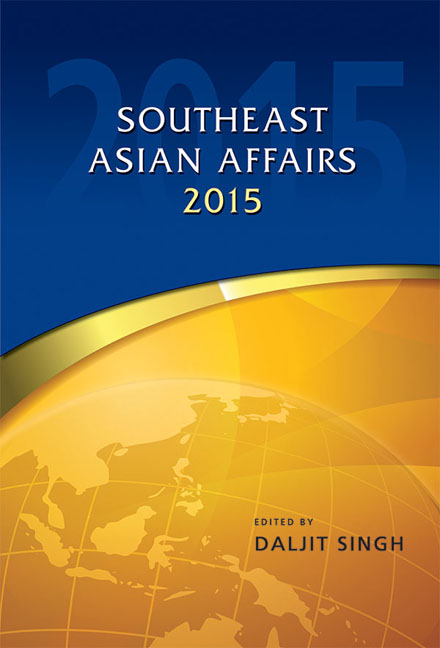Book contents
- Frontmatter
- Contents
- Foreword
- Introduction
- Acknowledgements
- THE REGION
- BRUNEI DARUSSALAM
- CAMBODIA
- Cambodia in 2014: The Beginning of Concrete Reforms
- The Cambodian People Have Spoken: Has the Cambodian People's Party Heard?
- INDONESIA
- LAOS
- MALAYSIA
- MYANMAR
- THE PHILIPPINES
- SINGAPORE
- THAILAND
- TIMOR-LESTE
- VIETNAM
The Cambodian People Have Spoken: Has the Cambodian People's Party Heard?
from CAMBODIA
Published online by Cambridge University Press: 19 May 2017
- Frontmatter
- Contents
- Foreword
- Introduction
- Acknowledgements
- THE REGION
- BRUNEI DARUSSALAM
- CAMBODIA
- Cambodia in 2014: The Beginning of Concrete Reforms
- The Cambodian People Have Spoken: Has the Cambodian People's Party Heard?
- INDONESIA
- LAOS
- MALAYSIA
- MYANMAR
- THE PHILIPPINES
- SINGAPORE
- THAILAND
- TIMOR-LESTE
- VIETNAM
Summary
Introduction
The 2013 national elections could be seen as a transformative event for Cambodian politics. Given its massive grassroots organizations, strong symbiotic relations with domestic tycoons and its control of state resources and institutions — particularly the security apparatus, the judiciary, and the National Election Committee (NEC) — the ruling Cambodian People's Party (CPP) was expected to win a landslide victory over the opposition Cambodian National Rescue Party (CNRP). This expectation was up-ended as large numbers of Cambodian people voted against the CPP, forcing the party to do some soul searching. This article addresses four points.
The first examines factors that led many people to expect CPP victory. The second focuses on reasons underlying the protest votes against the CPP and the CNRP's popularity. The third documents the popular protests organized by the CNRP and the CPP's responses that culminated in a political compromise; and the fourth addresses CPP's reform efforts since the election. It then concludes by outlining expected trends for the coming years.
The Expectations
The CPP went into the 2013 election cycle with strong prospects. First, the economy was strong, growing at a rate of over 7 per cent propelled by the agriculture, textile and tourism sectors. The CPP controlled all government institutions from the national to local levels including the National Election Committee. It also had a monopoly over the media; major television and radio stations are either affiliated with or owned by the CPP. As the Cambodian state has been synonymous with the CPP, the party was able to manipulate public goods transforming them into partisan resources. The CPP has strong organizational capacity with networks that link the state and business tycoons to local communities, creating a massive patronage-based vote-driving machine. The core of this structure is the party working groups comprising central party officials, senior government officials, and sub-national government officials with funding from these government officials and businesses. These working groups contributed resources for the construction of schools, roads, bridges, and offered a variety of small gifts including cash, monosodium glutamate (MSG), clothing and reading glasses. Nationwide opinion polls conducted by the National Republican Institute found 79 per cent of Cambodians believed that their country was headed in the right direction. Top reasons for people's confidence included the country's infrastructural improvement. Cambodia watchers generally believed that the CPP would win a comfortable majority even in the absence of electoral manipulation.
- Type
- Chapter
- Information
- Southeast Asian Affairs 2015 , pp. 102 - 116Publisher: ISEAS–Yusof Ishak InstitutePrint publication year: 2015

